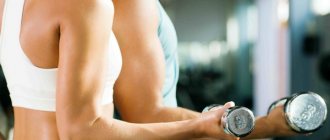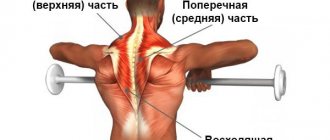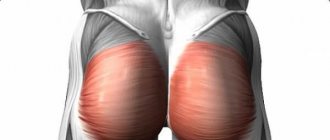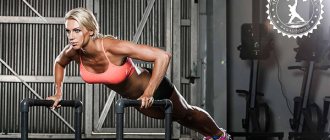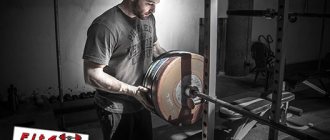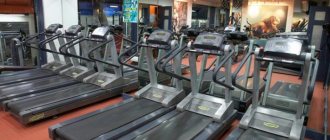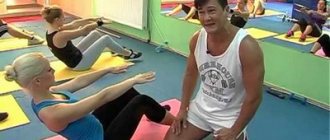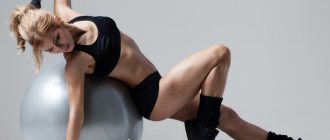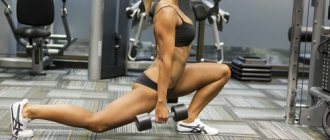The back muscles are the largest muscle group in the upper body. Developed back muscles visually enlarge the athlete’s body, making the shoulders wider and the waist narrower. This muscle group is the main one for building a V-shaped body, which is the main aesthetic component in an athlete’s body.
The back muscles can be roughly divided into 3 muscle sections:
- Trapezius muscles. They include the muscle section connecting the shoulder to the neck (commonly called the trapezius), as well as the muscles of the central upper back (along the spine from the neck to the lower back).
- Latissimus muscles. The largest section of the spinal muscles. Developed lats contribute to the growth of the back in width, and also narrow the waist against the background of this width.
- Lumbar muscles. Training this spinal region contributes to the development of a strong and reliable frame for the vertebrae. A developed muscular frame will create good protection against back injury.
We figured out the muscle departments. All that remains is to decide on the training. How to train your back? What is back muscle training in the gym?
Deadlift (Basic exercise)
The deadlift is the main basic exercise for training the back muscles. The main emphasis of the exercise is aimed at developing the lumbar region of the back. This type of exercise, together with the squat with a barbell, is the standard in bodybuilding, i.e. the most effective for overall muscle growth due to the promotion of greater release of its own (endogenous) testosterone.
- To perform the exercise, we will need a barbell and, if the working weight is large enough for you, safety elements in the form of a waist belt and garters on the wrist.
- It is imperative to learn how to perform the exercise efficiently for greater efficiency and less risk of injury. Until you fully master the technique of performing the exercise, we do not advise you to increase the weight. The mechanics of execution consist of lifting from the floor/lowering the barbell in a vertical plane from a squat position. You need to start the exercise by positioning yourself at the barbell: take the barbell shoulder-width apart, take a semi-squat position and keep your spine straight, slightly arching your back back. Afterwards, we gradually begin to lift the bar off the floor until the legs are fully extended. The moment when the legs are extended is the highest point of the exercise. The back at this moment should be arched slightly back from the plane of the body position. Then we begin to gradually, constantly keeping the spine straight, lower the barbell down, moving it along the legs, almost until it completely touches the floor. (When you work with a light weight, it is optimal not to bring the barbell to full contact with the floor. However, when the weight is large enough, a slight touch with a kick is allowed) This position is the lowest point of the exercise. At the bottom point, you are also in a half-squat position, your spine is straight (your back is slightly arched). Then we repeat the cycle. At the end of the exercise, lower the barbell to the floor (a gradual lowering with a straight back is also necessary). While performing the exercises, be as concentrated as possible, do not let yourself relax for a second until the end of the approach. Any slackening or loss of concentration increases the risk of injury.
The exercise consists of 2-3 warm-up approaches and 3 working approaches. Warm-up approaches are done with light weights. The weight of the apparatus in the warm-up approaches gradually approaches the weight in the working approach, preparing the muscles and joints for maximum loads. Number of repetitions in warm-up and working approaches: 6-8.
For a visual representation of how to perform the exercise correctly, watch the video below:
Deadlift. Classic style.
Basic exercises for men and girls
A set of exercises for pumping up the upper and lower back is suitable for both men and women who want to quickly and effectively pump up their back muscles.
Pull-ups
- Any athletic hall has a crossbar or, in common parlance, a horizontal bar.
- The classic grip for pull-ups involves positioning your hands with your fingers clenched away from you.
- The narrow position of the hands with this grip is very problematic due to twisting of the hands, so with this option they pull up with a medium or wide grip.
- During the exercise, the load falls on the outer part of the lats, the rear delta and the flexors of the arms, that is, on the conditionally upper part of the back of the torso.
- With good physical fitness, pull-ups can be done in 1-3 approaches with 6-12 repetitions in each.
Reverse grip pull-ups
- With this grip, the clenched fingers are directed towards you.
- In this case, you can pull yourself up with the narrowest grip when your hands touch each other.
- This gives a narrow positioning of the shoulder bones, which works not only the back, but also the outer lower part of the chest.
- The effect on the chest is similar to that of the pullover exercise, but the amplitude during pull-ups is even greater.
- The load on the arms also differs from pulling up with a regular grip - with a narrow position of the arms, the biceps are loaded more, and with a regular grip with a medium or wide position of the hands, the brachioradialis and brachial muscles work more.
Low bar pull-ups
- An option for those men and girls who lack the strength of the target muscles.
- A low horizontal bar allows you to help yourself with your legs when doing pull-ups, dosing the load and creating the required number of repetitions.
- Gradually, this version of the exercise will allow you to start doing pull-ups without using your legs.
Close-grip chest row
- Almost any athletic gym has a special device for training the back - a block consisting of a handle, a cable and weights attached to the cable.
- Unlike pull-ups on the bar, pull-downs allow you to finely adjust the load and make the movement technically cleaner.
- The muscles that work are the same as when doing pull-ups on the horizontal bar with a narrow grip - mainly the outer zones of the lats and the flexors of the arms, which means the exercise can be conditionally classified as working the upper back.
- To prevent weights from pulling the athlete upward from the seat, you need to fix your hips using special bolsters or a belt.
- The amplitude should be made as large as possible. At the peak point of contraction, pause for a couple of seconds and slowly return the handle up.
- Sharply throwing the projectile after a contraction reduces the effectiveness of the exercise, since the muscles also work when returning the weight to its original position, and not only when lifting it.
Deadlift
- This basic exercise uses the heaviest weight of the weight, since almost all muscle groups of the body are involved in the movement.
- Accordingly, this is one of the main movements in athletics, building mass and developing strength.
- The main load falls on the back extensors, quadriceps, lats and hamstrings, therefore, this exercise is conditional on the lower back.
- The movement consists of simultaneously extending the straight body at the hip joint and rising from a shallow squat.
- Great weight requires great responsibility. Deadlifts must be performed extremely correctly. The athletic gym makes it possible to select any weight for the barbell, allowing you to perform deadlifts technically flawlessly, depending on the strength of the athlete. You should not take excessively heavy weights that force you to round your back, which will inevitably lead to spinal injury!
Initial position:
- feet shoulder width apart;
- feet parallel;
- hands hold the barbell at shoulder width;
- the gaze is directed forward;
- the back is arched;
- you need to be as close to the bar as possible so that it touches your shins.
Technique:
- Smoothly begin to pull the barbell upward using your body and legs, keeping your back slightly arched and your arms straight.
- While moving, continue to look straight to prevent rounding of the back or loss of balance; do not lower or throw back your head.
- At the top point, pause for a second and smoothly lower the weight to the starting position.
- You can't throw weights.
- Maintain a straight back throughout the entire range of motion in both directions and keep the barbell as close to your feet as possible.
Bent-over dumbbell row
It loads the latissimus muscles, mainly their internal zones, as well as the trapezius, rear deltoids and rhomboids, so the exercise can be classified as working the upper back. Like any exercise with a bending load, it requires careful execution to avoid spinal injury.
Execution sequence:
- Select the desired weight of the barbell.
- Place your feet shoulder-width apart.
- Hold the barbell by the bar so that your hands are slightly wider than your shoulders.
- Bend your back and keep it in this position throughout the entire approach.
- Squat down slightly, pointing your knees slightly inward and moving your pelvis back slightly. A small squat allows you to remove harmful stress from the lumbar spine.
- The barbell hangs while bending over with straight arms.
- The gaze is directed forward.
- The tilt of the body at the hip joint should be from parallel to the floor to 45°.
- Smoothly pull the barbell towards your body at a level just below your chest and hold in this position for a couple of seconds.
- Elbows should be directed back and close to the body, and not sticking out to the sides.
- Smoothly return the bar to its original position.
One-arm dumbbell row
- Loads the same muscles as the previous exercise, but each side separately.
- And also this option is safer for the spine due to the rest of your free hand on the bench.
- Almost every gym is equipped with an athletic bench and a variety of dumbbells of any weight, so you don’t have to disassemble and assemble equipment for different exercises every time, as you have to do at home with one dumbbell.
Technique:
- Take a dumbbell.
- Bend your torso parallel to the floor, resting your other hand on the bench.
- Direct your gaze forward, straightening your back.
- Pull the dumbbell as close to your body as possible at abdominal level.
- Keep your elbow as close to the body as possible, pointing backward.
- After holding at the top point for a couple of seconds, smoothly lower the weight to the starting position.
- Do the required number of repetitions and approaches with both hands.
Deadlift on the machine
- A special simulator for training the back muscles creates a specific trajectory of arm movement, which provides a load uncharacteristic of free weights.
- Not every athletic gym has this device in its arsenal, but it is becoming more common over time.
- Allows you to perform traction with both hands at the same time, or with each one separately.
- Creates a load on the latissimus, lower trapezius, rear deltoids, rhomboids and other muscles of the upper back.
Upper block pull
- The exercise is similar to pulling a block to the chest with a close grip, but here the hands are placed wide and the grip is carried out with clenched fingers away from you, which allows you to slightly change the nature of the load.
- When visiting the gym, you need to take advantage of its benefits and regularly change exercise machines, working the muscles from different angles.
Lower block thrust
- Each hall should have such a block.
- The position of the torso and its relationship to the load vector is the same as during a bent-over barbell row, and the same muscles are involved, but the body is as if rotated 90° backwards.
- Conditionally works the upper back. The movement is performed while sitting, resting your feet.
- The handle of the block is pulled towards the body.
- Unlike a barbell, a block creates a slightly different type of load.
Hyperextension
Exercise for the lower back. Any self-respecting gym has special devices for hyperextension, consisting of leg hooks and a support pillow. There are options for apparatus for performing the exercise from different angles.
Procedure:
- Lie on a pillow with your upper thighs face down, placing your legs behind special bolsters and fixing your torso;
- Keeping your spine and legs straight, smoothly lower yourself to a right angle between your hips and torso;
- Smoothly raise your torso to the starting position when your legs and torso form one line and hold at the top point for a couple of seconds;
- You cannot bend backwards - this will create a harmful load on the lumbar spine;
- If the exercise is too easy, you can fold your arms across your chest, put them behind your head, or take additional weights, pressing them to your chest.
Pull-ups
If you want to make your back wider and more massive, then you need to take care of the development of the latissimus dorsi muscles. An exercise such as pull-ups will help you achieve this goal very well. Pull-ups are one of the most important exercises for developing the latissimus dorsi muscles.
- To perform the exercise, we will need a horizontal bar and, if pulling up with your own weight is not difficult for you, weights with a special belt for hanging these same weights on the body.
- The mechanics of the exercise is to perform lifting/lowering of the body on the crossbar (horizontal bar). You need to grab the bar as wide as possible. At the bottom point, you hang on the horizontal bar with your arms fully extended. At the top point, you swing on the horizontal bar with your arms bent to 90-120 degrees. As you do this, you evenly lift your body up as if you were pulling your pectoral muscles toward the bar. There is no need to throw your chin, it is enough to bring your pecs as close as possible to the bar.
The exercise either consists of 1 warm-up approach (if working approaches are performed with weights) and 3 working sets. Or 3 workers at once (if you do them with your own weight).
For a visual representation of how to perform the exercise correctly, watch the video below:
Pull-up technique on the horizontal bar.
Working on your muscles at home
A large number of exercises for the back do not require any special devices, and therefore they can be done not only in the gym, but also at home. They only need a floor, a rug and free space around.
To perform the first back exercise, push-ups, you will also need two-kilogram dumbbells. Lie on your stomach, toes pointing up, and your hands resting not on the floor, but on the dumbbells. Tighten your abs and start doing push-ups. Beginners can focus on their knees to make the task easier. And the more physically developed ones will move further: during push-ups while lying down, lift one hand off the dumbbells from the floor and bring it to the press. The next time you do a push-up, do the same with your other hand. Ideally, you should perform twenty push-ups and ten rows with your arms. You need to do three such approaches.
After this, lie on your stomach and stretch your arms forward. Lift your arms and straight legs off the floor, bending at the lower back. Hold this boat exercise for a few seconds. Slowly relax your muscles. You need to repeat it seven times.
Then extend your arms forward in the same way, raise your shoulders and legs. Swing all your limbs as if you were swimming crawl style. This exercise is performed for a minute. There are also three approaches.
The following exercise will help straighten your back. Lying on your stomach, lift your body up and lean on your hands. It is important that you lift using your back muscles, not your arms. Lock the top point and then smoothly return to the starting position. You need to do 5-10 repetitions.
The “plank” exercise is quite simple, but at the same time it requires remarkable endurance, as it works a whole group of muscles: the back, abdomen, thighs, buttocks. It works as follows.
- We lie on our stomachs on the floor, then rest our feet on the surface and our arms bent at the elbow (all the way on the forearm, not on the elbow itself).
- The back and legs should form a single line, the buttocks should not protrude, and the lower back should not be rounded.
- We hold this position for as long as possible, but not less than 30 seconds.
In a more complicated version of this exercise, which is within the capabilities of more trained people, you can lift one leg during the “plank” and maintain balance. Also, experienced athletes can do the “plank” not with bent, but with outstretched arms. Tighten your abs and try to stand like this for a minute or at least 40–45 seconds. Then stay in this position and squeeze your shoulder blades together. Then lift one hand off the floor and place your elbow behind your back. Change hands and repeat the exercise ten times on each. To begin with, one approach will be enough, but then perform this complex three times.
The back exercise “plank” is highly recommended for office workers, as thanks to it you can relieve tension from the shoulder girdle and neck muscles. Despite the visual simplicity of this element, its beneficial effect can hardly be overestimated. Planks are even recommended for people recovering from injuries to strengthen their back muscles. After just one ten-day course, if you increase the time you stand in the plank, you will notice how much better your back feels.
Strength exercises must be diluted with cardio training. At home, this could be jumping rope, squats, or active running in place. They need to be performed at a fast pace, one after another, for 60 seconds. It is necessary to do three approaches, between which a minute's rest is provided.
Vertical block thrust
The vertical pull-down is an exercise whose mechanics are very similar to pull-ups. If you find it difficult to do pull-ups with your own weight, then it is better to replace them with vertical pull-downs. If you want to thoroughly refine (finish off) your lats, then you can also turn to this exercise. The vertical block row allows you to slightly isolate the auxiliary muscles, thereby concentrating the load on the target ones.
- To perform the exercise, we will need a special simulator for block rows. Install the required handle on the upper mount of the machine. Adjust the foot rest to a comfortable height so that it presses your feet firmly against the floor. After installing the necessary weights on the simulator, you can begin to perform.
- The mechanics of performing the exercise consist of lowering/raising the handle in a vertical plane. The exercise is performed in a similar way to pull-ups. The handle is pulled towards the chest. At the top point, the handle is at the top, the arms are extended. At the bottom there is a handle below at chest level, the body is tilted slightly back. Lowering/raising the handle is carried out in front of the head.
The exercise consists of 1 warm-up approach and 3 working sets. The warm-up approach is done with 60-70% of the working weight. Number of repetitions in warm-up and working approaches: 8-10.
For a visual representation of how to perform the exercise correctly, watch the video below:
It's a lat pulldown, baby!
Work with dumbbells
An effective exercise for strengthening the back muscles for men is the dumbbell row. In this case, the hands are used alternately. This way the lats swing most effectively.
This method allows you to achieve an increase in the amplitude of movement, in contrast to classical traction, which is important, without putting excessive stress on the spine.
There are 2 variations of the starting position:
- sideways to the bench on which the left shin and knee are located, and the left hand rests against it. The torso tilts horizontally, the right leg moves back and to the side;
- feet are on the floor. But the right one protrudes above the left in the frontal direction and is curved at the knee joint. The bench serves as a rest for the left hand. The body assumes an inclined position.
Read more: Exercises with dumbbells at home. Complex for men and women
Done this way:
- Take the dumbbell in your right hand. In this case, a neutral grip method is used. Allow your arm to hang freely.
- Inhale, pull the dumbbell towards your waist or higher, visually outlining an arc. Hold the upper position for a couple of seconds and bring your shoulder blades together.
- Exhaling, return the projectile down.
These are good back exercises for men at home, since they require a minimum set of sports equipment - a dumbbell and a bench.
Important points:
- you cannot turn your body to lift the dumbbell as high as possible;
- Elbows should not go to the side.
Bent-over one-arm dumbbell row
The one-arm dumbbell row is an exercise aimed at developing the latissimus dorsi muscles.
- To perform the exercise, we will need any bench (or some other object) on which we can, fixed in an inclination, perform the exercise, as well as a dumbbell as a weighting agent. Before performing it, you need to take a comfortable position: lean on the bench with your hand, lean on the bench with one leg - on the same side as the resting hand, if required by the desire to maintain balance, the back is arched. Once you have taken the correct position, you can begin to perform.
- The mechanics of performing the exercise is to raise/lower the dumbbell in a vertical plane. At the lowest point, the dumbbell is at arm's length below, the target back muscle is stretched to its maximum. At the top - a dumbbell at the top at rib level, the target back muscle is contracted as much as possible. The exercise must be performed with a constantly arched back.
The exercise consists of 1 warm-up approach and 3 working sets. The warm-up approach is done with 60-70% of the working weight. Number of repetitions in warm-up and working approaches: 8-10.
For a visual representation of how to perform the exercise correctly, watch the video below:
Exercises for the back. Bent-over dumbbell row.
What exercise machines are suitable for working on your back?
Before any exercise in the gym or at home, a person should warm up his muscles well for further work. Give this ten minutes. Then you can begin the main set of back exercises. If you are new to the gym, be sure to consult an instructor who will tell you which back exercise machines in the gym are right for you. Since these units look quite intimidating, and it is not entirely clear how to handle them, ask a fitness specialist to instruct you.
Take your time and do each exercise thoughtfully to remember how to perform it correctly. Speed will come naturally with experience. Also, don’t try to load yourself half to death from the start. For a beginner in the gym, one set of each exercise is enough. The number of repetitions in each approach may not exceed twelve times. Also use minimal weights at first. But with each new workout in the gym, try to improve your results by increasing the load.
Of all the equipment in the gym, a machine that simulates rowing is perfect for working out the back. This is exactly the case when it works great with your back and at the same time is cardio, which means it helps you burn fat in the body faster. Rowing uses 98% of all the muscles in the body, thereby stimulating weight loss throughout the body, not just the back. In particular, the rowing machine also strengthens the abdominal and arm muscles. If you are incorporating cardio into your overall workout, then row for about 15 minutes and move on to the next exercise. But experts advise that for best results, dedicate one day in the gym to exclusively cardio training. In this case, devote half an hour to exercising on a rowing machine.
An alternative to this could be a weekly trip to the pool. Swimming is also a cardio exercise and has a great effect on your back muscles. Then you can build your schedule in such a way that you work out in the gym three days a week and in the pool one day.
Exercises on a hyperextension machine are good for losing weight on your back. Use it as follows:
- Lie on the machine with your stomach down, with your legs behind a special roller.
- We keep our legs and back straight, and then bend forward at the waist, lowering our torso down.
- Raise your straight back from the bottom point to the starting position.
The next effective exercise for the back is the deadlift, which can be performed by both men and women. Only in the latter case should the load be less. This barbell exercise works the muscles of the back, hips and buttocks. You need to ensure that your back is always straight. It is done this way:
Bent-over barbell row
Bent-over barbell row is an exercise aimed at developing the lumbar muscles and those running along the spine.
- To perform the exercise we will need a barbell rack and the barbell itself. Before performing, you must take the correct body position. It is at a certain position of the body that the target muscles are fully loaded. The first thing you need to do is take the barbell in your hands and straighten up completely. Next, arching our backs, we move the body a little forward - about 45 degrees from the plane of the body, while simultaneously bending slightly at the knees. With this body position, the barbell should hang freely on outstretched arms. Once you have taken the required position, you can begin to perform.
- The mechanics of performing the exercise consist of raising/lowering the barbell along the thigh muscles of the legs. At the lowest point, the arms are extended, the barbell is at the bottom. At the top point the bar is at the level of the pelvis. The exercise must be performed smoothly, without sudden movements, constantly monitoring the barbell.
The exercise consists of 1-2 warm-up approaches and 3 working approaches. Warm-up approaches are done with light weights. The weight of the apparatus in the warm-up approaches gradually approaches the weight in the working approach, preparing the muscles and joints for maximum loads. Number of repetitions in warm-up and working approaches: 6-8.
For a visual representation of how to perform the exercise correctly, watch the video below:
It's the BENT-UP ROW, baby!
Back exercises in the gym - general recommendations
Strong spinal muscles activate energy and metabolic processes in the human body. And if they are not strengthened with special exercises, symptoms of various diseases may appear, often osteoporosis and osteochondrosis.
Regular exercises help the muscles cope with the heavy load on the spine, which is caused primarily by a person’s incorrect vertical position and sedentary lifestyle. However, before you start doing the exercises, you need to familiarize yourself with the general recommendations:
- The approach to training should be comprehensive. Use several types of exercises for each group of spinal muscles and alternate them with each other.
- During exercise, be sure to do exercises on other parts of the body so that your muscles are developed proportionally.
- Try to make your breathing even and deep, without holding it when the load increases.
- Avoid jerking and sudden actions.
- Remain calm if even after 2-3 weeks you do not see much result. It often appears after 4-5 weeks of regular training.
- Stick to a schedule for training, as the randomness of doing exercises reduces their effectiveness.
- Do this or that exercise from 6 to 15 times depending on your level of training, and the number of sets is 2-3 times with a break of up to 4 minutes.
- It’s better to exercise 3-4 times a week, but do your best.
- Suitable morning time for classes is from 09:00 to 11:00 or evening – from 18:00 to 20:00 for 50 minutes. - 1 hour.
- The menu should have enough protein, since it is the building material for muscles.
- Before and after training, try not to eat fatty foods as they impede your metabolism.

